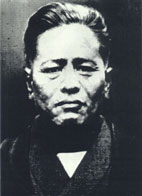
Chojun Miyagi

Master Miyagi was highly respected within the karate community. He has been called be many the greatest Okinawan karate master. Miyagi spent his entire life studying, perfecting, and transforming karate. He was Master Hagishionna’s top student and was named his successor. Not only did Miyagi study the Naha-te system, he was also able to travel to China throughout his life and study different Chinese systems of the martial arts. Miyagi taught his system in the Okinawan schools, at his house, and to the Okinawan Police. Master Miyagi is said to be the father of Goju-Ryu (Hard/soft style). It is said the he devised this system in the 1920s making it a relatively newer system. The “Go” stands for the “hard” part of the system, while the “ju” stands for the “soft” side of the system. Miyagi came up with this name after he had sent one of his top students, Jinan Shinzato, to a meeting in Japan of numerous martial artists. When Shinzato was asked to name his system, he responded with Hanko-Ryu (the half-hard style), which up to this point had had no name. Upon returning to Okinawa Shinzato reported the story to his master, Miyagi. This got Miyagi thinking, and ended up inspiring him to use the name Goju-Ryu, which is a concept that he had learned from his studies of the “Bubishi”. Miyagi relied heavily on the teachings of the Bubishi. In fact, he even created the kata Tensho from the techniques that were taught in the Bubishi. Miyagi also introduced forced breathing, called “Ebuki Breathing”, into his system. This breathing was placed into the Sanchin kata. Miyagi traveled all over, trying to spread his style of hard/soft. He gave numerous clinics and demonstrations in mainland Japan. These efforts were not in vain. In 1933 the Dai Nippon Butokukai, or the “Greater Japan Martial Arts Association, accepted Goju-Ryu as an official style of martial arts. Meitoku Yagi was named Miyagi’s successor and received his “menkyo kaiden”, due to the fact that Miyagi’s top student Shinzato had died at the end of WWII.
